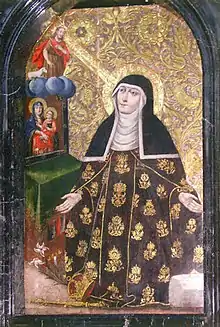Kinga of Poland
Kinga of Poland or Kinga of Hungary, also Saint Kinga (also known as Cunegunda; Polish: Święta Kinga, Hungarian: Szent Kinga) (5 March 1224[1][2]– 24 July 1292) is a saint in the Catholic Church and patroness of Poland and Lithuania.[3][4]
Kinga of Poland | |
|---|---|
 | |
| Born | 5 March 1224 Esztergom, Kingdom of Hungary |
| Died | 24 July 1292 (aged 68) Stary Sącz, Kingdom of Poland |
| Venerated in | Catholic Church |
| Beatified | 11 June 1690, Saint Peter's Basilica, Papal States by Pope Alexander VIII |
| Canonized | 16 June 1999, Saint Peter's Square, Vatican City by Pope John Paul II |
| Feast | 24 July |
| Attributes | Depicted as an abbess; crown |
| Patronage | Poland Lithuania |
Biography
She was born in Esztergom, Kingdom of Hungary, the daughter of King Béla IV of Hungary and Maria Laskarina. She was a niece of Elizabeth of Hungary and great-niece of Hedwig of Andechs. Kinga's sisters were Margaret of Hungary and Jolenta of Poland. She reluctantly married Bolesław V ("the Chaste") and became princess when her husband ascended the throne as High Duke of Poland.[5] Despite the marriage, the devout couple took up a vow of chastity. The marriage was largely arranged by, and the vow of chastity patterned after that of Bolesław's sister, Salomea of Poland.[6]
During her reign Kinga got involved in charitable works such as visiting the poor and helping the lepers. When her husband died in 1279, she sold all her material possessions and gave the money to the poor. She soon did not want any part in governing the kingdom which was left to her, and decided to become a Poor Clare nun in the monastery at Sandec (Stary Sącz). She would spend the rest of her life in contemplative prayer and did not allow anyone to refer to her past role as Grand Duchess of Poland. She died on 24 July 1292, aged 68.
Alexander VIII beatified Kinga on 11 July 1690.[7] In 1695, she was made chief patroness of Poland and Lithuania. The cause for her canonization was opened on 13 July 1741,[7] and on 16 June 1999, she was canonized by Pope John Paul II.[8]
Legend
Legend has it that Kinga threw her engagement ring into the Aknaszlatina salt mine in what was then Hungary. The ring miraculously traveled along with salt deposits to Wieliczka, where it was rediscovered. On this spot the miners erected a statue of Saint Kinga, carved entirely from salt, which is 101 meters under the Earth's surface.[9]
Sources
- Kristó 2003, p. 248.
- Klaniczay 2002, p. 439.
- "Katolikus.hu St Kinga". www.katolikus.hu. Archived from the original on 3 March 2016. Retrieved 13 February 2015.
- "St Kinga". Catholic Encyclopedia. 1915. Retrieved 13 February 2015.
- Sokol, Stanley S. (1992). "Cunegunda (Helen)". The Polish Biographical Dictionary: Profiles of Nearly 900 Poles who Have Made Lasting Contributions to World Civilization. Bolchazy-Carducci. p. 74. ISBN 9780865162457.
- Klaniczay 2002, p. 242–243.
- Index ac status causarum beatificationis servorum dei et canonizationis beatorum (in Latin). Typis polyglottis vaticanis. January 1953. p. 54.
- Berglund, Bruce R.; Porter, Brian A. (2010). Christianity and Modernity in Eastern Europe. Central European UP. pp. 368 n.61. ISBN 9789639776654.
- "wielizka-mine-an-underground-cathedral-". /www.googobits.com. Archived from the original on 2014-12-05. Retrieved 26 November 2014.
- Kristó, Gyula (2003). Háborúk és hadviselés az Árpádok korában [Wars and Tactics under the Árpáds] (in Hungarian). Szukits Könyvkiadó. ISBN 963-9441-87-2.
- Klaniczay, Gábor (2002). Holy Rulers and Blessed Princes: Dynastic Cults in Medieval Central Europe. Cambridge University Press. ISBN 0-521-42018-0.